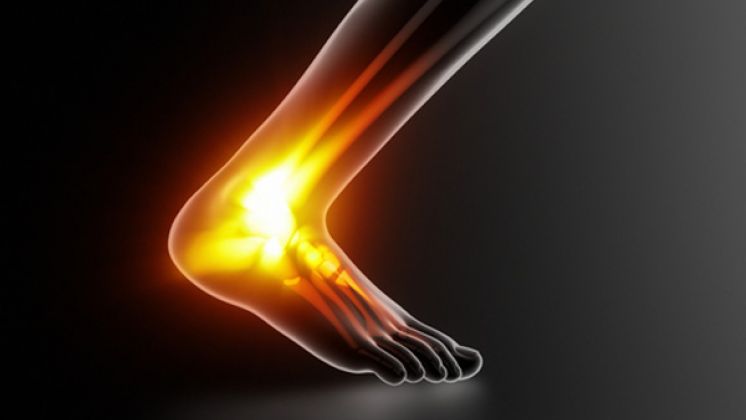How To Fix Ankle Injuries
Physiotherapist Lucy Macdonald explains some of the most common ankle injuries and how to treat them

How The Foot And Ankle Work
The ends of the long bones of the lower leg, the tibia and fibula, sit either side of the talus forming the ankle. The bones are held together with lots of ligaments, fascia and the small muscles of the foot. The foot can move up and down, side-to-side and rotate inwards and outwards and its stability is greatly affected by the health of the above mentioned structures as well as other joints further up the chain, particularly the hips. Therefore treatment of a foot problem should always include the assessment and biomechanical correction of these joints.
Common Foot And Ankle Injuries
Achilles tendinopathy
What it feels like: Pain comes on gradually at the back of the heel and ankle, the achilles feels thickened and tender to touch, and often feels stiff first thing in the morning.
Common cause: Achilles tendinopathy used to be called ‘tendinitis’ until research showed that the condition was not inflammatory which is what ‘itis’ means. It is caused by incorrect loading of the tendon either due to poor lower leg alignment or a sudden increase or change in exercise. Alignment issues can be caused by bad footwear or incorrect movement patterns that your body has unintentionally learned. These movement patterns can be retrained by a physiotherapist.
How to treat Achilles tendinopathy: This exercise is one of the components of treating an Achilles tendinopathy and must only be done with the guidance of your physiotherapist and if the pain came on slowly.
- Stand on the edge of a step holding onto a banister with your heels hanging off the back of the step and your knees slightly bend.
- With your weight on the non-painful side go up onto your tiptoes on the step kneeping your knees slightly bent.
- Transfer your weight onto the painful side and very slowly lower yourself down so that the heel hangs right off the edge of the step. Repeat 30 times, always transferring your weight onto the good leg on the way up and your bad leg on the way down.
- Your physio will then progress you to do the exercise with weights, then faster but you MUST NOT do this on your own or you could cause more damage!
Plantar fasciitis
What it feels like: Pain in the sole of your foot particularly under the heel. It often feels stiff and painful first thing in the morning and gets worse the longer you're on your feet.
Common cause: Damage and inflammation of the plantar fascia – a thick band of tissue that extends from your heel to your toes and works as a shock absorber. Often caused by a combination of an increase in training, weight gain, inadequate footwear, poor biomechanics and poor foot posture. The latter can be treated with insoles and foot specific exercises but all of the other components need to be considered for recovery to be possible.
How to treat plantar fasciitis: Short-term relief of the painful plantar fascia can be achieved by carrying out the following exercise
- Take a small plastic bottle of water and freeze it.
- Wrap the frozen bottle in a tea towel, put it on the floor and roll the sole of your foot back and forth on the bottle for five to 10 minutes.
- Rest for five to 10 minutes and then repeat.
- Do not rest the foot on the bottle as you might get an ice burn.
Lateral ankle ligament sprain
What it feels like: The most common ankle sprain is of the outside of the ankle – twisting it on an uneven surface or with a sudden turn or fall during sport (or in the pub). Sudden pain around the outside of your ankle, swelling, increased temperature and if it's a severe pain, putting weight through it.
Common cause: The sudden movement tears the lateral ankle ligaments. The symptoms can be confused with a bone break or fracture so you MUST see a physiotherapist or doctor who will decide if you need an x-ray. If in doubt, do not put any weight on it until you have had it x-rayed of you could do more damage.
Get the Coach Newsletter
Sign up for workout ideas, training advice, reviews of the latest gear and more.
How to prevent a lateral ankle ligament sprain: The best way of preventing a lateral ankle ligament sprain is to develop your proprioception, which is your body’s positional sense. When you sprain your ankle, proprioception is reduced and the following exercise is therefore an essential part of rehab. But it must only be started when pain and swelling have gone completely.
- Stand on one leg with your hands hovering over a support so that you can grab hold of it easily if you lose balance.
- Close your eyes and time how long you can stand like this.
- If you can do this easily for one-minute then do the same with tiny knee bends. If this is easy, do tiny heel raises with your eyes closed.

Lucy Macdonald has been a sports physiotherapist since 2004, with experience treating professional and amateur sports people including members of the GB ski and powerlifting teams.









